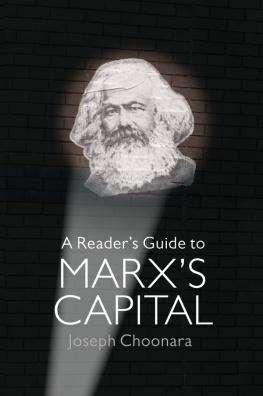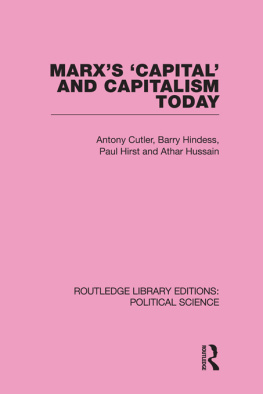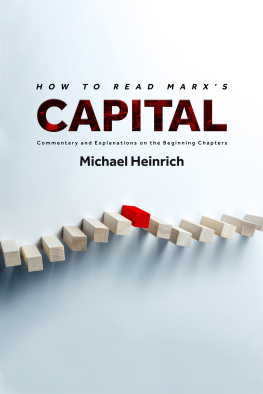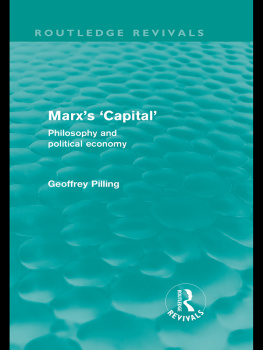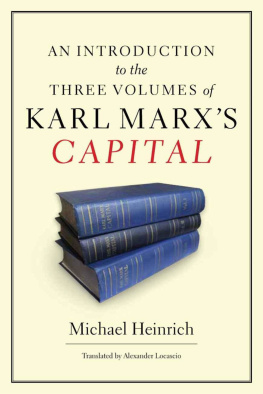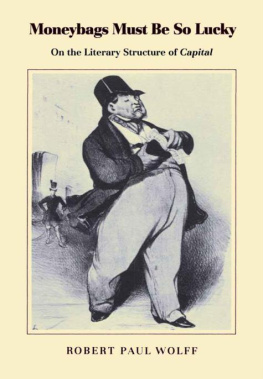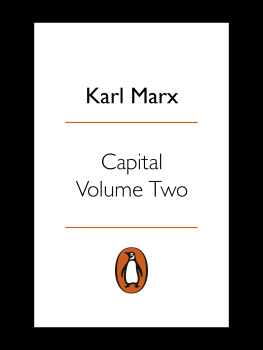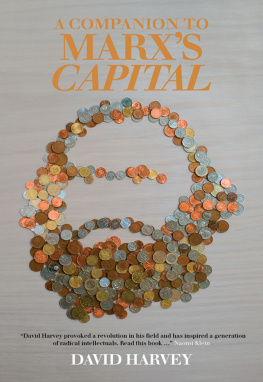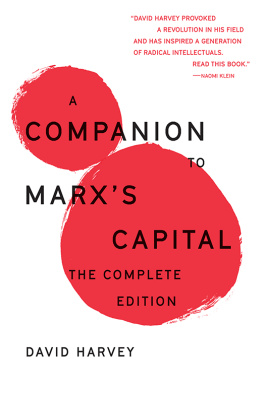Joseph Choonaras A Readers Guide to Marxs Capital is a timely contribution to helping those new to Marxs analysis of capitalism, now 150 years since it was first published. Choonara clearly explains the context, method and purpose of Capital, before taking the reader steadily through each chapter of the book. Marx hoped that he would gain a readership among a working-class audience for his book. There have been a few past attempts at producing guides for readers to promote that objective: Choonaras is by far the best.
MICHAEL ROBERTS, author of The Long Depression
This book stands out as an accessible and lucid guide to Marxs Capital. It cuts to the chase in clarifying the essence of his ideas. At a time when there is a thirst for understanding the chaotic and crisis ridden nature of capitalism, Joseph Choonara makes an important contribution to the intellectual tool kit for activists.
JANE HARDY, Professor of Political Economy,
University of Hertfordshire
A Readers Guide to Marxs Capital is a very valuable, clearly written and succinct aid to understanding Marxs most important work. Choonara adheres to the long unfashionable but true notions that Marx had a coherent approach that structured Capital and that his analysis reveals the fundamental logic of capitalism during his lifetime as today. In this it is vastly superior to other recent, competing introductions.
RICK KUHN, author of the Deutscher Prize winning
Henryk Grossman and the Recovery of Marxism,
Honorary Associate Professor in Sociology,
Australian National University
About the author
Joseph Choonara is a columnist on Socialist Review and a frequent contributor to the journal International Socialism. His previous publications include Unravelling Capitalism: A Guide to Marxist Political Economy (second edition, Bookmarks 2017).
A Readers Guide to
Marxs Capital
Joseph Choonara

A Readers Guide to Marxs Capital
by Joseph Choonara
Published 2017 by Bookmarks Publications
c/o 1 Bloomsbury Street, London WC1B 3QE
Bookmarks Publications
Cover design and typesetting
by Peter Robinson
Printed by Short Run Press Ltd
ISBN 978-1-910885-48-2 PBK
978-1-910885-49-9 Kindle
978-1-910885-50-5 ePub
978-1-910885-51-2 PDF
Contents
Preface
THIS BOOK is neither a general introduction to Karl Marxs political economy nor a treatise exploring the intricacies of Capital or its application to contemporary capitalism. Instead it aims to assist those reading the first volume of Capital, whether as part of a reading group or through individual study. It assumes no prior knowledge of Capital or of economics more generally, merely a desire to grapple with this compelling and, for many readers, somewhat intimidating work. It is designed to be read in parallel with Capital itself, with each chapter of this book consulted either before or after digesting the relevant sections of Marxs work.
Experience shows that a competently run reading group, perhaps led by someone who is already acquainted with Capital, is the best way to gain an understanding of Marxs text. The growing interest in Marxs political economy means that it is easier to find people prepared to participate in such a group if one does not already exist. However, in the absence of this, it is certainly possible to read Marx alone. In either case, the problems tend to come quite early on, in the dense opening chapters of Marxs text. Here a readers guide such as this may be especially helpful in providing assistance and reassurance in getting to grips with the intricacies contained in these important early sections.
I have tried to make this work quite brief. It is not helpful to re-explain each passage from Marx, as much of his writing is entirely self-explanatory and clear. I have instead dwelt on those areas that are the most vital to an overall understanding of the work and those that most often confuse, drawing on my own experience teaching Capital to left-wing audiences of students and workers over the past decade.
Explanation is inseparable from interpretation and without doubt my own particular foibles are on display in this work. I have, however, tried to make clear where my own interpretation is at odds with that of other Marxists, without becoming too embroiled in the mass of controversies that have emerged within Marxist political economy over the decades.
I have used the Penguin edition of Capital, translated by Ben Fowkes, and it is strongly recommended that readers obtain this version. It is now the standard English-language edition and offers the best translation. In my text, numbers in square brackets refer to pages in this version of Capital. References to other works that may aid comprehension are included in footnotes.
This work only covers the first volume of Capital. That is a genuine limitation as the three volumes form an interconnected whole and anyone who wishes to understand thoroughly Marxs account of the laws of motion of capitalism must delve into the second and third volumes, edited and published by Frederick Engels after Marxs death. Nonetheless, a thorough understanding of the first volume should provide an adequate basis for the later volumes to be explored independently.
Finally, this book developed out of a Capital reading group I ran at the Bookmarks bookshop in London in 2016-2017. I am grateful both to Bookmarks for letting me use their facilities and to attendees at those meetings for forcing me to reconsider my understanding of elements of Marxs work and for allowing me to test on them some of the explanations contained here. Thanks also to Lina Nicolli, Peter Robinson and Carol Williams for their work on the production.
A note for reading groups
In this work, each chapter after my introduction corresponds to a chapter of Capital. However, those running Capital reading groups will quickly find that the chapters in Marxs work vary enormously in length and difficulty. I have found that the contents can be conveniently covered in 14 sessions, as follows:
Session 1: , sections 1-3
Session 2: , section 4
Session 3:
Session 4:
Session 5:
Session 6:
Session 7:
Session 8:
Session 9:
Session 10:
Session 11:
Session 12:
Session 13:
Session 14:
__________
On the former, readers can consult my own introduction, Unravelling Capitalism: A Guide to Marxist Political Economy (second edition, Bookmarks, 2017), or Ben Fine and Alfredo Saad-Filhos Marxs Capital (sixth edition, Pluto, 2016). Alex Callinicoss Deciphering Capital: Marxs Capital and its Destiny (Bookmarks, 2014) is an unparalleled work for those wishing to grapple with the complexities of Marxs work. Chris Harmans final book, Zombie Capitalism: Global Crisis and the Relevance of Marx (Bookmarks, 2009), is the best starting point for those who wish to see how Marxs theories can be creatively applied to the modern world.
Introduction
CAPITAL is an extraordinary work, one that retains all its relevance today, a full 150 years after the publication of the first volume. That is not to say that we can simply apply the work uncritically to contemporary capitalism. Creative application of the theory, updating and developing it where necessary, is essential. Yet they book has a real longevity. This reflects the fact that the object of investigation in
Next page
